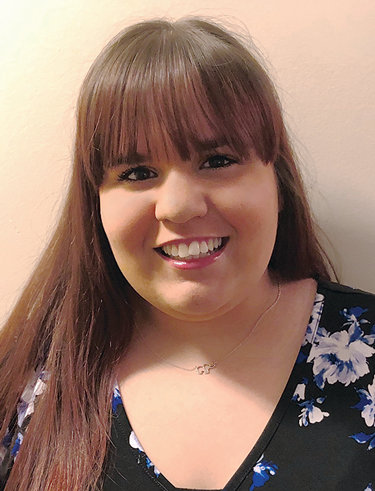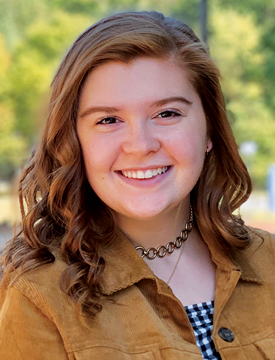Sydney McGowan completed her student-teaching experience during the pandemic — she just never went into a classroom.
A remote clinical practice placement prepared her to become an educator in ways she never thought possible, said McGowan, a graduate of The College of New Jersey who is now teaching full time.
During the fall 2020 semester, she was a student-teacher in a first grade class at Robbins Elementary School in Trenton. The virtual student-teaching experience was positive, but she was thankful for having previous in-person experiences — something many students may not ever have due to changes in school formats caused by the coronavirus outbreak.
“Engaging a class of virtual students through a computer poses different but equally challenging issues to engaging a class which is partially virtual and partially in-person,” she said.
Luckily, her cooperating teacher was a “fantastic example” of how to manage a virtual classroom.
“The most prevalent shift I had to make in my expectations was how to handle classroom management,” recalled McGowan. “It takes a lot of work to cultivate a classroom environment of respect, motivation, and community in person. Trying to do the same task through a video screen was a culture shock.”
When schools suddenly pivoted to online instruction in the spring of 2020, student teachers helped teachers by recording lessons, reaching out to parents and students, and working with children in small groups, said Eileen Heddy, director of support for teacher education programs at The College of New Jersey.
“Many cooperating teachers remarked that they did not know how they would have met all of the challenges of remote learning without their teacher candidate as their partner,” Heddy added.
Notably, the student teachers were instrumental in researching and learning how to effectively use a variety of apps and tools, sharing them with the teacher, and collaborating to use them in class.

Virtual Teaching Troubles Marissa Realdine, a senior at Stockton University, has done most of her placements virtually and completed her clinical practice completely online.
Realdine, who is also vice president of NJEA Preservice, was in the midst of completing a 50-hour placement in the spring of her junior year when the state locked down.
“I completed 34 hours in the classroom before we were shut down,” she recalled.
Because the school she was assigned to was not meeting, Stockton gave her access to videos on teaching. They asked her to write a reflection on each, and she had to watch 16 videos — one for each hour of the experience she had yet to complete.
“I never met any of the students,” she said. They used Google Classroom with no virtual meetings. Realdine had to set up assignments, grade them and leave feedback for students. It wound up being good because she had to use Google Classroom during her senior year placement, which involved virtual meetings daily.
The virtual format emphasized small-group instruction whenever possible, McGowan said. She had to make an extra effort to check in with students individually and address gaps in knowledge that might have gone unnoticed during the whole-class instruction time, she said. They used breakout rooms and facilitated small-group instruction during afternoons to improve student learning, but the time was limited.
One of the biggest hardships of virtual learning is that students don’t have as much time to work in groups or with partners, as they can’t be left alone, Realdine said.
“My students barely know one another unless they had class together in previous years, and it’s very sad to see that there isn’t much camaraderie between them,” she admitted. “They aren’t getting that social interaction that they need.”
Teaching equitably to all students was nearly impossible for McGowan, because children were in different settings with varied materials, noise levels, internet access, and guardians.
For instance, some of McGowan’s students could not print worksheets because they didn’t have printers at home. Others logged in from day care centers, so they weren’t free to move around.
“Creating lessons that could be successfully completed by every student became a Herculean task,” McGowan said.

Struggling to Meet Requirements McGowan knows that universities and K-12 schools are trying hard to support student-teachers in fulfilling their requirements. At TCNJ, there was no option to request a placement at a school based on whether they were in-person or remote.
She scrambled sending out emails in order to figure out how to fulfill her requirements. “It certainly, takes much advocating on the student teacher’s end to ensure those requirements are met,” she said.
Even though she completed her clinical experience, McGowan could not take the educative Teacher Performance Assessment (edTPA), which is a requirement for state certification, which is needed to teach.
New Jersey requires education students to complete 50 clinical experience hours prior to participating in two semesters of clinical practice, which is known as student-teaching. Colleges and universities can extend the requirement.
In addition to completing a clinical placement, students must pass the edTPA assessment and the Praxis II content exam to earn a Certificate of Eligibility (CE).
The New Jersey Department of Education (NJDOE) waived the edTPA requirement, which has been put on hold as the COVID-19 public health emergency continues. Under an executive order, anyone who can’t complete the assessment can be evaluated with alternative assessment methods. That’s how McGowan fulfilled her requirements.
The DOE was flexible in issuing temporary CEs to those who did not meet the basic skills test or test on subject matter knowledge, said Margaret Renn, director of the office of field experiences at William Paterson University of New Jersey. This will allow them to get jobs and extend the time they have to meet assessment requirements until July 31, 2021.
Placement Problems Realdine considers herself lucky that she got a placement. Some of her peers had unresponsive mentor teachers, difficulty entering buildings, and reduced interaction with students.
Recognizing the challenges, the state released a toolkit to support districts in placing student-teachers.
“Some students needed to find alternative ways to complete the hours,” she said. “I was just lucky enough to get a steady placement, so I accepted the fact that I wouldn’t have the student teaching experience I expected.”
In addition to financial hardships that demanded student teachers work additional jobs, they had less time for clinical preparation, Renn said.
“Some were also challenged to pay for and take the required assessments required for licensure,” Renn added.
Additionally, some school districts were unable to work with teacher candidates due to uncertainties about being able to open schools.
“This narrowed the possible clinical opportunities for teacher candidates for both the fall 2020 and spring 2021 semesters,” Renn said.
As of March 2021, Realdine said her placement district did “a fantastic job” of embracing student teachers.
“There are multiple in my building and district, and they never make us feel like a burden or an extra challenge,” Realdine said.
“I have learned so much in this remote placement that I never would have learned in person, but I would be lying if I said that I’m getting all the same experiences,” Realdine said. She has excelled at adapting to educational technologies and devising ways to engage students, but said she has not learned proper classroom management.
“That is something I will need to work on,” Realdine said. “My cooperating teacher tells me the tricks she uses, but it’s not the same as being able to actually practice these skills. And I don’t get to make a connection with the students like I would in the classroom…although I try very hard.”
Overall, Realdine said she is glad her mentor teacher and district have supported her in the experience. That said, it’s “definitely not how I pictured my senior year to play out.”
Remote Student Teaching Advantages McGowan’s remote experience immersed her into some of the challenges that teachers have been facing — a benefit as it expanded her perspective on how to educate children.
Another advantage of remote student teaching was having freedom to create and plan lessons, as her cooperating teacher was willing to try any sort of website or activity she came up with to keep the students excited about school.
“Since we both were learning how to be successful in a virtual classroom, she was very gracious with her classroom and allowed me to take the lead in lessons quite early in the semester,” McGowan recalled.
“Recreating in-person lessons for a virtual setting can feel like creating a curriculum for the very first time. Countless hours get put into creating virtual materials from scratch, researching websites that are engaging but age-appropriate, adding audio files to written work to account for varied reading levels in the classrooms, and more,” she said.
Though it wasn’t the experience she anticipated, McGowan said it taught her more about patience, dedication and flexibility than she would have received in a physical classroom.
“There was no better way to learn skills such as differentiation than by being thrown into the fire and reckoning with each students’ varied environments each day during school. While it was no doubt exhausting, it equipped me with a sense of preparation for any type of situation,” she added.
Colleges, Universities Pivot to Prepare Students Maqueda Randall-Weeks, faculty director of clinical experiences and an assistant professor of professional practice at Rutgers’ Graduate School of Education, said pivoting to virtual education was challenging, but all their students were able to complete their clinical practices. For the most part, students had a good experience whether put into a virtual, hybrid or in-person classroom — once everyone “found their groove.”
“The major challenge was securing placements in districts that were not part of our partner network,” Randall-Weeks said. “Understandably, districts were concerned with increased physical bodies in the buildings and were unsure of their opening strategies, so our request was an added layer. However, most districts were somewhat receptive to placements.”
Randall-Weeks thinks student teachers should highlight their pandemic teaching skills, which will translate well to physical classrooms when schools do reopen.
“They learned to work in new environments that match our current professional landscape,” she added. “This was amazing training for them since we are still unsure how our educational world will look over the next few years.”
